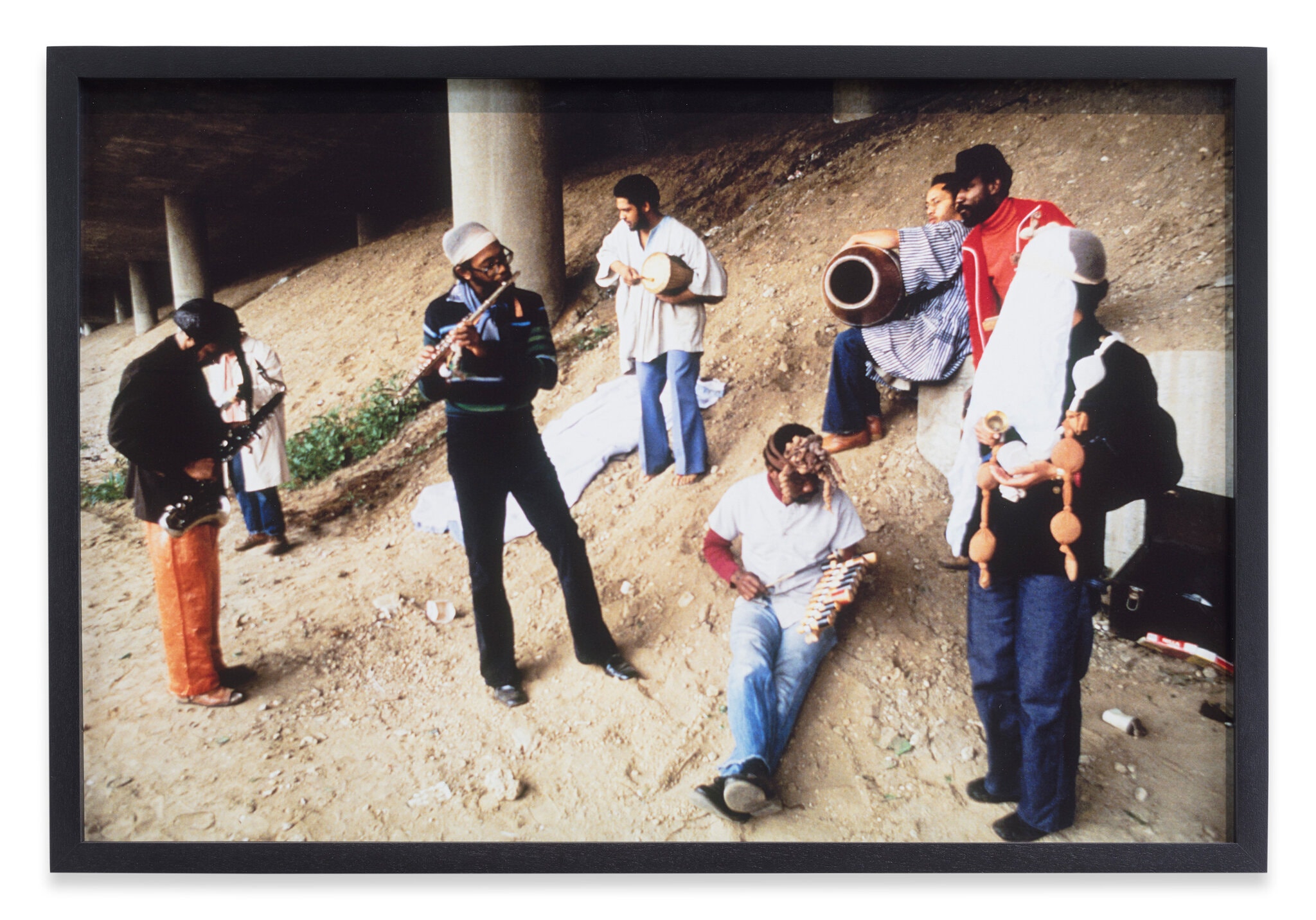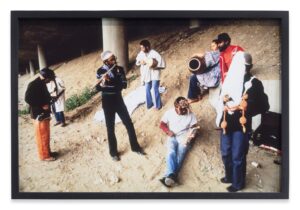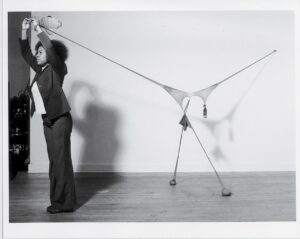
An Artist’s Continuing Exploration of the Human Form

IN 1975, AFTER the birth of her first son, the artist Senga Nengudi began making a series of sculptures with nylon pantyhose, prompted by the physical and psychological changes she experienced during pregnancy. She was in her early 30s, a first-time mother, and fascinated by how her own body had grown and morphed. She wanted to express the human body’s elasticity, how it could expand and contract like her sinuous new material, which she cut, ripped, and tied. She’d then fill these amorphous forms with sand, which, she said, gave her sculptures a “kind of sensuality that the body has.”
From a distance, they looked like amoebas, and up close they bulged and rippled like flesh. In one of her early installations 1977’s “R.S.V.P. I” she took 10 pairs of nylon pantyhose in varying shades of tan, many of them previously worn, and pinned the ends taut to the walls of a room while filling the center gusset with sand, creating forms that were simultaneously spindly and bulbous, sensuous and monstrous. She once described them as “abstracted reflections of used bodies.” There were thematic precedents for Nengudi’s sculptures in the alien-like abstractions of Louise Bourgeois and in Bruce Nauman’s assemblages of mundane objects like wallboard, but the way she manipulated a drugstore accessory into a visceral invocation of the human form was nothing less than startling.
These pieces became known as the “R.S.V.P.” works, named for the enigmatic announcement card for Nengudi’s first New York solo show — was it an exhibition title or a request? at the gallery Just Above Midtown in 1977. The dozens of “R.S.V.P.” sculptures Nengudi went on to make over the next few years had their own personalities: Some, like “R.S.V.P.” (1975-77), a dark brown pair of pantyhose that splayed open like stretched legs, with other sand-filled hosiery hanging over it like pendulums, were expansive and friendly; others, like 1976’s wishbone-shaped “R.S.V.P. V,” were claustrophobic and menacing. Sometimes, Nengudi, who had been dancing since childhood, used the sculptures as both settings and partners for intricately choreographed performances that responded to the work’s distinct form and are preserved in black-and-white photos from the time, with the artist or one of her friends (or both) clad in nylon tights and entangled in her work.
In the decades after she debuted them, Nengudi’s sculptures became icons of the Black Arts Movement, the multidisciplinary intellectual flourishing in the ’60s and ’70s that coincided with and gave artistic shape to the rising political activism and Black nationalism of the era. They have also become touchstones in feminist art (a concurrent artistic movement) for the way even their materials tear apart, in a literal sense, traditional notions of femininity. (Nengudi has noted that, because of the humbleness of her materials, she could “put my entire show in my purse”: “I started thinking, ‘What is the core of a woman’s existence? The purse,’” she said.)
And yet, for decades, she lingered on the periphery of the art world: always creating but rarely seeing her work in mainstream galleries and museums. The ’70s may have been an era of inspired creativity, but it was also a decade of rigid boundaries and narrow identities both within the establishment and outside it and Nengudi’s pieces were difficult to categorize. She was a sculptor, but one who used cheap or found materials. She was a dancer, but at the heart of her performances were these strange creations. Her work was too conceptual to be embraced by the mainstream art world as “Black art,” which expected a strictly figurative and sociological view of Black life in America, but it was also too distinctly personal to be celebrated alongside the mostly white men who defined the conceptual art of the era. She was uncategorizable in an age that, for all its experimentation, still treasured systems of organization.
In December, though, nearly 50 years after she began making the “R.S.V.P.” series, a retrospective of Nengudi’s work will be on view at the Denver Art Museum. The show makes plain the extent to which Nengudi and her work were essential fulcrums around which gathered a community of Black artists — fellow genre-defiers like David Hammons, Maren Hassinger, and Lorraine O’Grady — who were likewise ignored by the mainstream art world in their formative years but have since been recognized as some of our most significant living artists. On her quest to discover herself and reflect on her own experiences, she also broadened the very notion of what a Black artist could be.
NENGUDI WAS BORN Sue Irons in Chicago in 1943. Her father died when she was 3 years old, and after several years, her mother decided to head west. “She had this love of California,” Nengudi said of her mother, Elois, a graceful woman fond of serving rice and beans on fine china with a bottle of champagne. “She only made one trip out there, and that was enough for her.” Nengudi is based in Colorado Springs, where she has lived for the past 31 years, but she was speaking to me over Zoom from a cavernous, mostly unadorned studio in Boulder, where she was on a residency. Her voice, unusually soft, echoed off the high ceilings as she stared a little beyond me.
She grew up between Los Angeles and Pasadena. As the only child of a single working parent — her mother was an escrow officer she spent a lot of her time alone, parked in front of a television, watching Fred Astaire, Lena Horne, and Katherine Dunham. She admired Dunham, in particular, who was one of Hollywood’s first Black choreographers and was captivated by Astaire’s use of props, like a hatrack or an umbrella. The way he moved with objects — transforming the inanimate into something alive and kinetic — influenced her own later performance pieces. “I want dancers to be activators,” she said. “I want them to partner with the sculpture.” Indeed, it was movement, more than visual art, that informed Nengudi’s early creative life. She took both ballet and modern dance classes. It wasn’t until she was in college that she was forced to make a decision between pursuing a career in visual art or in dance. At that time, she “didn’t have what they considered a dancer’s body,” she said. Dancers were expected to be tall and thin, which Nengudi wasn’t. There was also the question of longevity and sustainability: As a dancer, there were physical limits to what her body might allow her to do overtime. Those restrictions did not apply to artists. “I felt that you could live forever and still be an artist,” she said. “You can live to 100 and still have the ability to express yourself.”
Nengudi majored in fine arts at California State University, Los Angeles, where she was one of two Black students and the only Black woman in the art department. “Oftentimes, I was the only Black person in a room. Sometimes it was OK, and sometimes it was not,” she said. “It was lonely.” But two discoveries made her feel less alone. The first was the Pasadena Art Museum (now the Norton Simon Museum), where she worked as an assistant art instructor and encountered the works of Jasper Johns and Robert Rauschenberg, as well as happenings: free-form, predominantly improvised performances that artists like Claes Oldenburg and Red Grooms first began developing in the late 1950s by creating stage sets out of everyday materials such as cardboard and encouraging viewers to move about freely in them. They were a way of demonstrating that art was and could be anything an artist wanted, and this freedom, combined with how the museum introduced art to children — employees would take kids through the galleries and dance in front of the works gave Nengudi the confidence to develop her own ideas about dance’s fellowship with art. The second transformative space for her was the Watts Towers Arts Center, a community hub in the historically Black neighborhood of Los Angeles that was co-founded by the legendary sculptor Noah Purifoy. Here, Nengudi discovered more ways to rethink what art could be, this time centered around Blackness. In 1965, the Watts neighborhood was the site of a six-day uprising ignited by an altercation between a Black motorist and a white police officer. The rebellion radicalized a number of Black artists at the time and, as numerous businesses were damaged or destroyed, inspired a cultural shift in Black art toward assemblage, the process of making work from discarded materials. Although Nengudi’s work was already moving in this direction, she credits Purifoy for reinforcing her understanding of aesthetics and what it means to be an artist. “Noah was the most amazing man because he walked his talk, he didn’t really care about money, he cared about the creative process and art itself,” Nengudi said. She was also inspired by the elementary- and middle-school-age students in her mixed-media classes at Watts Towers, marveling at their “open-ended way of dealing with art. You say, ‘Oh, dear, that’s a beautiful flower you’re painting,’ and then they take black paint and paint all over it.”

But it was after college, in 1966, that Nengudi had one of her most important educational experiences while attending a postgraduate program at Waseda University in Tokyo. She’d chosen Japan because of her interest in the Gutai group, the Japanese collective who, like her, were using found objects and performance to redefine artistic practices. At the time of the group’s founding, Japan was a country in flux and in the midst of a deep identity crisis. Just shy of a decade out from the humiliation of World War II, it was trying to square its ancient traditions with a second industrial revolution, and the Gutai group, who were admirers of Abstract Expressionist painters like Jackson Pollock, sought, as they put it in their 1956 manifesto, “to go beyond abstraction.” They preceded modern performance artists, who wouldn’t come into their own in the West until later in the 1960s: The Gutai group’s paintings were made by rolling in a pile of mud, or by foot instead of a hand, or by jumping through a paper screen. Nengudi was in awe of their spontaneity, their defiance. “I was just floored,” Nengudi said of their work. “I said, ‘This is it. This is what I am about.’”
Nengudi had anticipated some culture shock upon arriving in Japan, as well as racism, but once she got to Tokyo, she was “treated so graciously.” In fact, her only bad experience came from an encounter with white Americans in the city’s well-touristed Ginza district. She was immediately taken with Japanese culture and became interested in theater traditions like Kabuki and Noh. The way ritual governed life in Japan from how people answered the phone to how they bathed influenced her as well. The country had a sophisticated but simple elegance that resisted the Western impulse to “clutter something up,” she said in a 2013 oral history interview with the Smithsonian Institution. A year later, Nengudi left Tokyo for America with “a deep desire to find a connecting link” between the culture she had just experienced and the one to which she was returning.
In many ways, she found that link in New York, where she moved in 1971 on the advice of a professor who told her that the city was a boot camp for artists. She arrived six years after the poet LeRoi Jones (who later changed his name to Amiri Baraka) had moved to Harlem; his relocation, in the eyes of some, created a distinction between an “uptown” artist (those who, like Baraka, were working within the framework of Black nationalism) and a “downtown” one (those who appealed to a mainstream, mostly white, crowd). Nengudi’s decision to live uptown was rooted in a desire to be closer to those from whom she could learn and affirm her own identity as a Black person. “It was more like an adventure I was so excited about Blackness,” she said. “I wanted to know everything about myself that was not available in Los Angeles.” She moved into an apartment in East Harlem and began working as an instructor at the Children’s Art Carnival, a community program started by the Black artist Betty Blayton-Taylor, who was also a sculptor. In her spare time, she hung out with the Harlem-based Weusi Artist Collective, whose members invoked African themes and symbols in their work. She was inspired by all of New York’s qualities, from how the neighborhoods were rigidly divided along racial lines to the various ways people celebrated their ethnic backgrounds, as in the annual West Indian Carnival, which included a parade.
Although she was inspired, Nengudi didn’t show much work during this period, in part because she didn’t fit neatly into the mold of either an uptown or downtown artist, but also because she was too shy. But she did create, and the project that came out of this period seems to portend the “R.S.V.P.” works: a series of two-dimensional silhouettes, slightly larger than an actual person, which she cut out of colored cloth meant for flags and tied to scaffolding and fences or dangled between alleyways. Even in these early works, which she called “spirits” or “souls,” one can see how she would eventually influence an artist like David Hammons, who after moving to New York would make art in the ’70s and ’80s from materials discarded on the city streets empty glass bottles, bottle caps, human hair and install them in inconspicuous public areas, as if in secret. These were sculptures influenced by movement: Representations of the heroin addicts Nengudi would see high on the street corner, swaying back and forth, flirting with the ground but never falling. “It was such a dance,” she said. “This movement, unfortunately, it was what it was, but it was graceful.”
AFTER THREE YEARS, in 1974, Nengudi returned to Los Angeles. New York had changed her in many ways: It deepened her understanding of Black history and culture, as well as validated her sense of self, imbuing her with new confidence. But it wasn’t until the birth of her first child — with her partner at the time, Rene Pyatt, who died shortly thereafter — that she had a revival. “Even though I spent most of my life without a child, it felt like my life began when they were born,” she said of her sons (her second — with her husband, Elliott Fitz, a retired electrician — was born in 1979). Motherhood made her hyperaware of her own body. Giving birth moved her to search for a material that could withstand repeated manipulations that would mirror, she says, the “kind of freaky” experience of having a human being develop in your own body. Along with her stint in New York, it also inspired a new identity: After becoming a mother, she decided to change her name from Sue Irons to Senga Nengudi. “Senga,” she was told, meant something akin to a sage in the Bantu language Lingala.
The name proved prophetic or was perhaps a promise on which Nengudi made good. Over the following decades — in which white-owned galleries remained essentially closed off to Black artists, and museums continued to ignore them — Black artists were confined to exhibiting in libraries and community centers. With the official channels of the art world unavailable to them, Nengudi and her peers had to create new ones for themselves. She began a series of large public collaborations that became hallmarks of the era. Along with artists like Maren Hassinger — who also used everyday objects to create sculptures she started the collective Studio Z, members of which participated in Nengudi’s first public group performance, 1978’s “Ceremony for Freeway Fets.” The performance, which ran for less than an hour, took place under a highway near the Los Angeles Convention Center and consisted of a small ensemble of artists playing various instruments a saxophone, a flute, and drums and Nengudi, Hammons, and Hassinger dancing in elaborate costumes. Hassinger represented the female spirit (wearing one of the pantyhose sculptures on her head like a crown) while Hammons, the male spirit, wore bright-colored pants and carried a decorative staff. Nengudi, wearing a white tarp and mask, acted as the bridge between the two gendered energies. “I wanted to kind of do an opening ritual to celebrate and christen the area it was in,” Nengudi said; the site represented the crossroads of a wide variety of cultural and ethnic identities in Los Angeles and reminded her of an African village.
Although there is no surviving footage of the performance, it was documented in Roderick Young’s photographs, which chronicle a remarkable moment of Black art in Los Angeles in the 1970s. In his photos, the gathering appears as a kind of celebration anointing Nengudi the de facto leader. When she talked about the performance later with the filmmaker Barbara McCullough, who was present for the ceremony and later included it in a film, Nengudi described herself as “practically possessed” and lost in a “rapture.” “Over the years, I have described her as a mild-mannered wild woman,” McCullough said of Nengudi recently. “Her ideas are so expansive and somewhat disconnected from the normal way of thinking.” McCullough learned from Nengudi that “you could do your art with anything.”
Studio Z encouraged Nengudi to be more outward with performance. But the collective also reminded her of the importance of relationships and interactivity, a theme that remains key to her practice. “We would get together to try and push the envelope and find new ways of doing things and new vocabularies for ourselves,” Nengudi said. One of her most important and longest collaborations was with Hassinger, who is best known for her sculptures composed of industrial materials like wire rope, and whose friendship with the artist began with long phone conversations, the kind that, Hassinger said, people just don’t have anymore. “They would be all over the place,” Hassinger said. “A lot of it would center around art and projects that we were working on, but a lot of it would also be gossip and raising children and making dinner.” They also had a shared background in dance: Both women had studied under instructors from the Lester Horton company, the first in the United States to be racially integrated.
Hassinger became one of Nengudi’s primary collaborators in the “R.S.V.P.” performances, and they have remained fixtures in each other’s work for nearly 40 years. In photographs of a 1977 performance at Pearl C. Wood Gallery in Los Angeles, Hassinger, who has an Afro and is wearing a black bodysuit and tights, activates the sculptures by entrapping herself in the nylon pinned to the gallery wall. In another image, Hassinger sits in a kind of boat pose — feet lifted, knees pulled to her chest and hands supporting her body — as the nylon wraps around her chest, thighs and head. The choreography recalls the simple, usually spontaneous gestures of the Gutai group, or the nodding-out addicts Nengudi first encountered in New York years earlier. The movements varied from performance to performance and depended on the shape and size of the sculpture, but the intervention of a human form within one of the sculptures — a hand stretched out to the wall, or propped up on her head mid-handstand — seemed to enhance the humanlike characteristics of Nengudi’s work until both forms were indistinguishable from each other.
Like the rest of contemporary art, performance works had up until this point been presented as a largely white activity, populated exclusively by the same lithe bodies that had marginalized Nengudi as a dancer years earlier. There was so little to compare it to in the late ’70s that it was easy to overlook just how groundbreaking it was to see two Black women in their 30s, with Afros and curves, contorting their figures in form-fitting clothing, while Nengudi’s strangely beautiful nylon forms wrapped around them like an old friend, holding them in her embrace.
AFTER THE “R.S.V.P.” series, Nengudi began working on increasingly ambitious projects while continuing to experiment with found materials and nontraditional spaces. In “Masked Taping” (1979), she covered her body from the knees up in pieces of masking tape and had herself photographed as she moved about her darkened studio as a ghostlike outline. And in a 1996 solo exhibition, “Wet Night — Early Dawn — Scat Chant — Pilgrim’s Song,” she used found objects like baking pans, dry cleaner bags, chopsticks, and Santeria candles to pay homage to religious iconography and the relationship between the real and unreal.
But in 2003, she returned to the “R.S.V.P.” series, recreating some of her original nylon sculptures, after her friend Lorraine O’Grady insisted “there was still energy in them.” By this time, Nengudi was in a different stage of her life. She was teaching at the University of Colorado and caring for her ailing mother, who had been paralyzed by a stroke (she died in 2004). Remaking the pieces was a challenge. First, the nature of the materials had changed: “You think of pantyhose as pantyhose, but no, they have different crotches; they have different elasticity,” she said in the Smithsonian oral history. But she was also a different person, and in the process of preparing these works, Nengudi began to reflect anew on how they related to her own body. Whereas she had once seen them as a metaphor for new motherhood, she now began to see them in relation to the sexual abuse she had suffered as a child, something she hadn’t even told her mother about. “I’ve never really mentioned it because I didn’t want my work to be seen with a narrow lens,” Nengudi said. “But there are some elements in there that I think have to do with that abuse.”
She was between 10 and 13 years old and living in Los Angeles. It was one of her mother’s boyfriends. She feared talking about it because he had threatened to kill her mother if she did. In remembering this period, Nengudi expressed appreciation for the way her mother, who was also being abused by the boyfriend, brought her into the decision-making process. When Nengudi’s mother had enough money to leave the relationship, she had two choices to purchase a car or rent a new home. She asked Nengudi what she wanted to do. “I said, ‘If we get a car, then we can run away,’ and she says, ‘OK, that’s what we’ll do,’” Nengudi said.
The pandemic has made Nengudi reflect more about what had happened to her as a child, because she’s been thinking about children for whom home is not a safe space: What will happen to them, to their bodies? For more than half her life, in her distortions of the human form, she has been exploring how we occupy our own bodies. “I often say, the psyche as well as the body can, you know, stretch and come back into shape,” she said. “But sometimes it doesn’t.” This may not have been the original intention of the works, but it is what they have become: a story of bodies in transformation, acting and being acted upon, doing their best to exist in the world.


